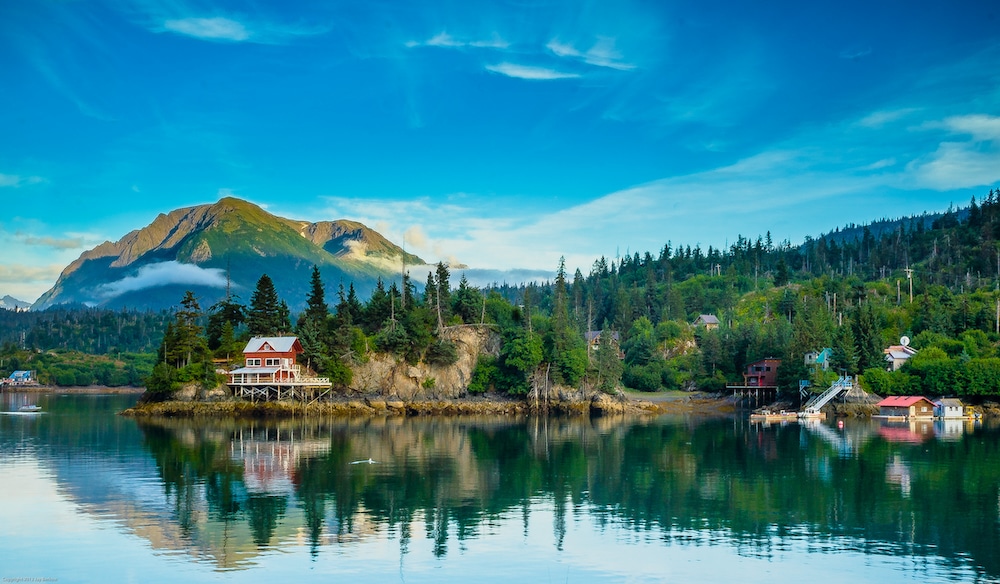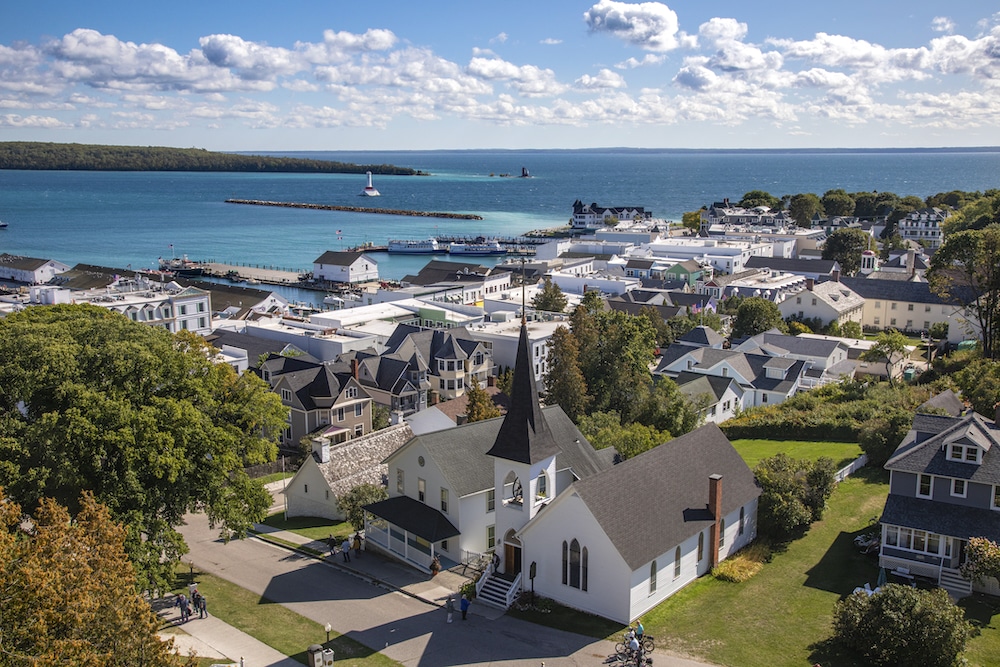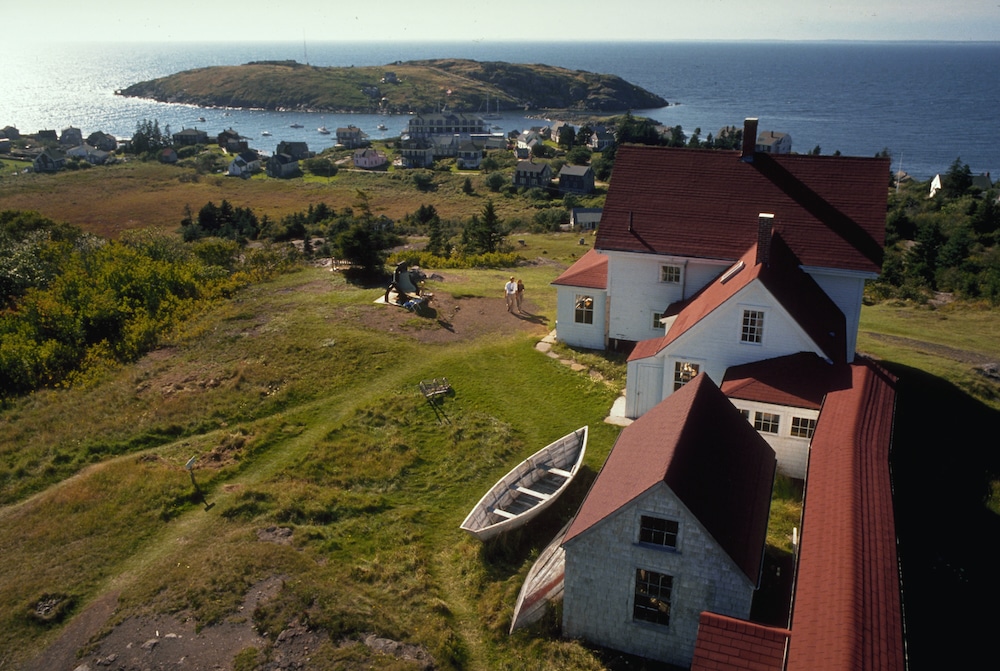
If you’re looking to get away from the rushed routine of modern life, these four car-free towns, each with its own languid pace, might be just for you.
Halibut Cove, Alaska

Alaska is a land of unspoiled wilderness and abundant wildlife. If there is going to be a human community there, it makes sense for it to be car-free.
Located within the northern part of Alaska’s first state park, Kachemak Bay State Park, the small community of Halibut Cove shares its tree-ringed bay with bald eagles, harbor seals, sea otters, porpoises, whales and other native species.
The 400,000-acre state park features mountains, glaciers, coastline, ocean and forests. Stunning views of the Kenai Mountain Range with its spectacular Harding Icefield give this little sanctuary a presence like no other.
For thousands of years, Alaska Native Peoples occupied the area around what is now Halibut Cove. The town itself was founded around 1911 by Scandinavian settlers.
To get to Halibut Cove, you can catch a water taxi in Homer, Alaska, and getting around the 8.12-mile island is done on foot, boat or all-terrain vehicle.
Activities in this tucked away village include hiking, kayaking, strolling along the bay or visiting local art galleries. There are a number of trails, and if you’re up for a long hike, the 6.5-mile Grewingk Glacier Trail will lead you through unspoiled forest of cottonwoods and spruce to shimmering Grewingk Glacier.
There are a variety of lodges and other accommodations in Halibut Cove, as well as a coffee shop and restaurant. Besides being free of cars, another unique feature of the town is that it is home to one of the only floating post offices in the United States.
Mackinac Island, Michigan

Famously the setting for the Christopher Reeve-Jane Seymour film Somewhere in Time, Michigan’s Mackinac Island feels similarly timeless. Known for its sunrises, quaint boutiques and local fudge, this motorized vehicle-free town has nature trails instead of roads. More than 80 percent of the 3.8-square-mile island is part of Mackinac Island State Park, the first state park in both the state and the country.
“As soon as I board the ferry for the short trip to Mackinac Island, I immediately feel more relaxed. The pace of transportation on the island is slower than on the mainland and, without a car, I interact more with my surroundings. Whether traveling by foot, in a carriage, or on a bicycle, I’m more connected to the sights, sounds, and even the other people there,” Michigan novelist Cynthia Birk told EcoWatch.
The island is located between the upper and lower peninsulas of Michigan on Lake Huron and has plenty of 19th century architecture and comfortable inns, but no chain hotels. The entire island and its natural harbor, Haldimand Bay, located at the south end, are a National Historic Landmark.
“I love being on the island in the early morning or in the evening. It’s so quiet compared to the busy energy of midday. If I’m near an open window or sitting on a beautiful porch and hear the clip-clop rhythm of a horse-drawn carriage going by, it’s like a little moment of time travel. I feel more connected to the history of the area. It’s a wonderful experience!” Birk added.
Supai, Arizona

If you’re looking to not only get away from cars and roads, but civilization together, you can take an eight-mile hike to Supai, the most remote town in the continental U.S. Not only are there no roads in Supai, there are no roads to Supai.
Members of what is now the Havasupai Tribe — Havasupai means “people of the blue-green waters” — have lived in this village on the edge of the Grand Canyon for 1,000 years. The Havasupai Indian Reservation was established in 1880, but substantially expanded in 1975. It consists of 188,077 acres of land on the South Rim of the Grand Canyon.
To get to the closest point to the Village of Havasupai by car, follow historic U.S. Route 66 to Highway 18, then drive 63 miles to Hualapai Hilltop. This is the point from which you will hike down into the village. All supplies in the village, located in Havasu Canyon, must be brought in by mule or on foot. Even the mail is delivered by mule. Once in the village there is a lodge and a store with a café.
The blue-green waters of Havasu Creek feed into Havasu Falls. Camping and swimming are permitted at the falls and in the creek, which maintains a temperature of about 67 degrees Fahrenheit year-round, a little chilly, but good for a refreshing swim after a long hike. The creek is a tributary of the Colorado River, the architect of the Grand Canyon.
Due to the lack of cars, city lights and noise pollution, camping in Supai to the sound of rushing water under a blanket of stars is a true escape from modern civilization.
Monhegan Island, Maine

Houses overlooking the ocean on Monhegan Island, Maine. Philip Gould / Getty Images
Monhegan Island was first settled by Native Americans who fished its plentiful waters. Meaning “out-to-sea island” from the Algonquin word “Monchiggon,” there are no bridges or roads connecting this one-of-a-kind getaway to the mainland. Scheduled boat service, which does not allow cars or bicycles, is available from Boothbay Harbor, New Harbor and Port Clyde.
The only way to explore Monhegan Island is on foot over 17 miles of hiking trails and dirt paths that wind along the island’s one square mile of rocky terrain.
“I’m on the island, looking across at Manana Island, all bare but for a few crouching spruce trees, two thatched cottages, and, other than that, just grass, sheep, goats. It looks like the Arans out there,” writer and teacher Shaina Kapeluck shared with EcoWatch from writings on Monhegan Island. “[G]aily-colored Adirondack chairs, fierce ochre lichen on the chimney stones. Gnarled wind-riven spruces full of mourning doves, berms of unripe currants, more rugosa roses, the brightest I’ve ever seen. A [m]inke whale surfaced when our ferry approached the island. Willow, buttercups, cattails and fern, bluebells, plants I’ve never seen. Cormorants scooting low from island to island.”
This small community of fewer than a hundred year-round residents has a lot to offer both visitors who are there for the day or those making an overnight trip. Two of the main attractions are the Monhegan Lighthouse, built in 1824 and the second-tallest lighthouse in the state of Maine, and the Monhegan Museum of Art and History.
The island is perfect if you’re looking for a slower pace and to be inspired, as the community has a rich artistic history. An artist colony was established there in 1890 that has hosted landscape painters such as those from the Pennsylvania Academy of the Fine Arts and the New York School of Art. American masters Edward Hopper, Rockwell Kent and Robert Henri are some of its well-known alumni.
If you’re an artist yourself and would like to experience the island as a subject, the Monhegan Artists’ Residency, established in 1989, offers a weekly stipend, free board and studio use to those who are accepted.
“Spruces tall as city hall, and, out of the pine-duff muffled silence, kinglets and [S]wainson’s thrushes and black-throated green warblers. A pearly pheasant in the rise, calm and curious as a chicken. The blackberry flowers in full, white crepe-de-chine flush. Grackles cackling as the rain came down, and a cardinal, of all people, saying ‘isn’t-it -weird-though, what-a-weirdo, weirdo, weirdo,’” Kapeluck mused.
Other points of interest include a shipwreck off the southern part of the island near Fish Beach, as well as the rocky granite cliffs of Black Head, the highest point on the island. Scale Black Head’s 160 feet to enjoy panoramic views and watch the sunset. Swim Beach is a popular spot, but if you brave the cold water, watch out for strong tides.
“There is a schoolhouse here. Some families live here all year. The rocks I’m out on now are Black Head, and the rocks I walked to yesterday are Burnt Head. There’s the swim-beach, where you can swim, which has a rivulet of rainwater running down that generations of kids have tried to dam with rocks and seaweed, and the fish beach, where the fishermen used to bring cod up and clean it onshore. They don’t do that anymore, but it is still considered gauche to swim there,” Kapeluck shared with EcoWatch.
Accommodations on Monhegan Island include the 1816 Island Inn, which has a dining room with ocean views and an array of fresh seafood. Other places to eat are The Barnacle, serving coffee and pastries, and The Fish House, located on Fish Beach. There is also Monhegan Brewing Company, where some of the craft beer labels were designed by previous artists-in-residence.
“Stargazing was way better before the 1980s, Elena says, before electric light came to Monhegan. She lit Kerosene lamps at the inn, hung the sheets out to dry. Even so, clear skies tonight after last night’s fog had me back on the trail, back out to the gannet rock, up to the cemetery below the lighthouse where the Murdocks, McDonalds, Nelsons and Piersons lie buried. No matter where I stood I saw the house-lights, heard the sora peeping in the marsh, saw the lighthouse beam sweeping it all in like a security camera. I saw the mesh work of the Milky Way, saw a single meteor scrap its chalk dust across the sky,” Kapeluck wrote.
Whatever you choose to do on this charming watery outcrop ten miles from the Maine coastline, it will surely be memorable and car-free.
The post 4 of the Most Picturesque Car-Free Towns in the U.S. appeared first on EcoWatch.
